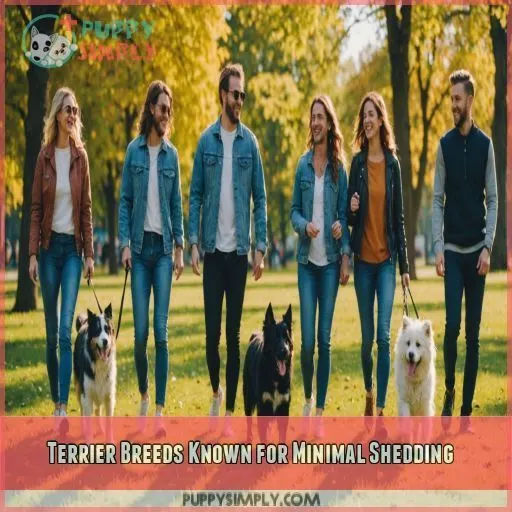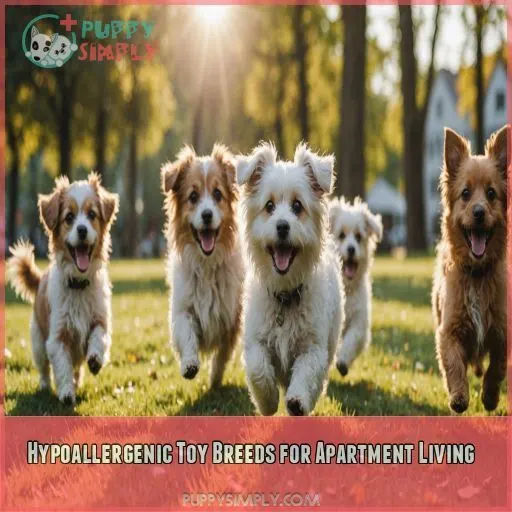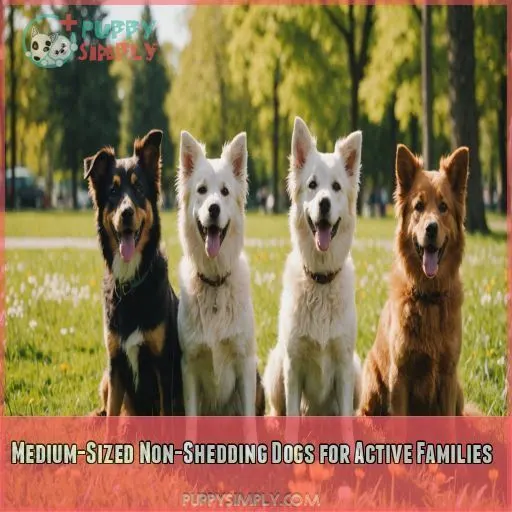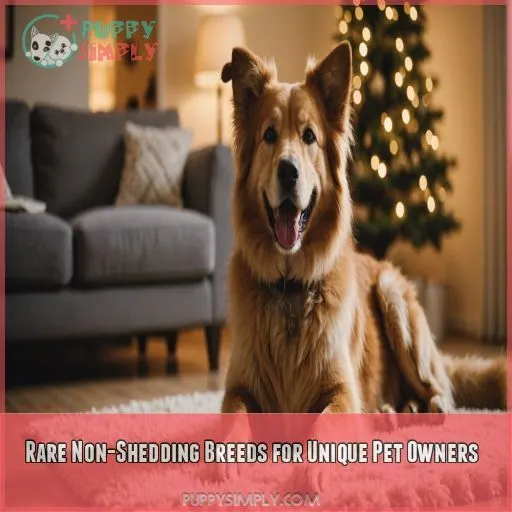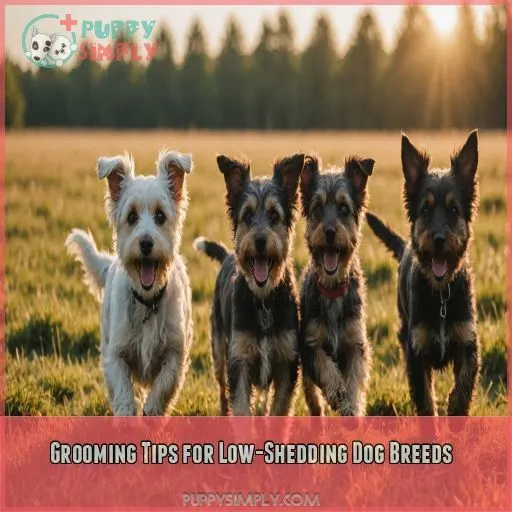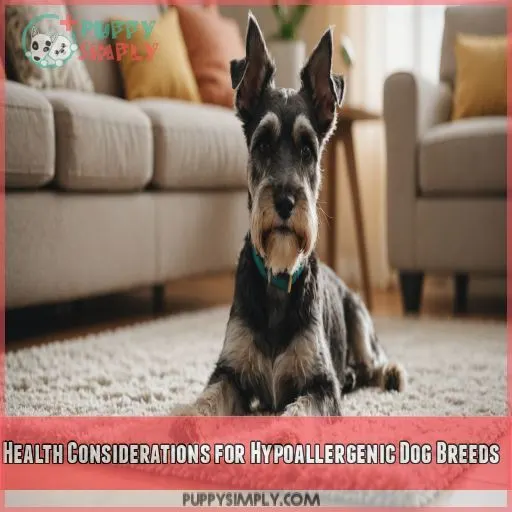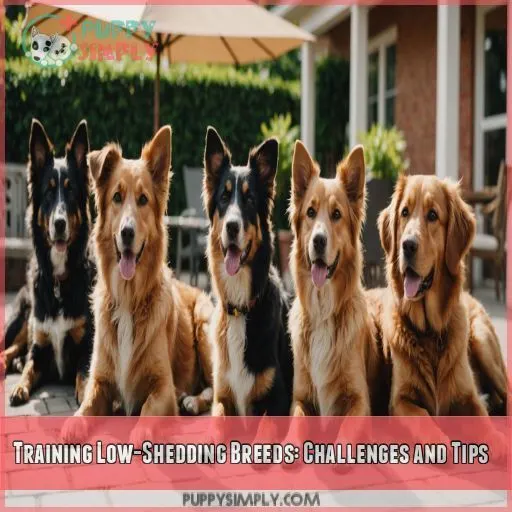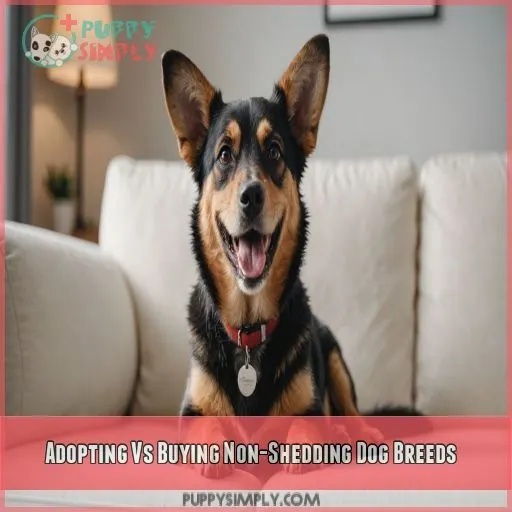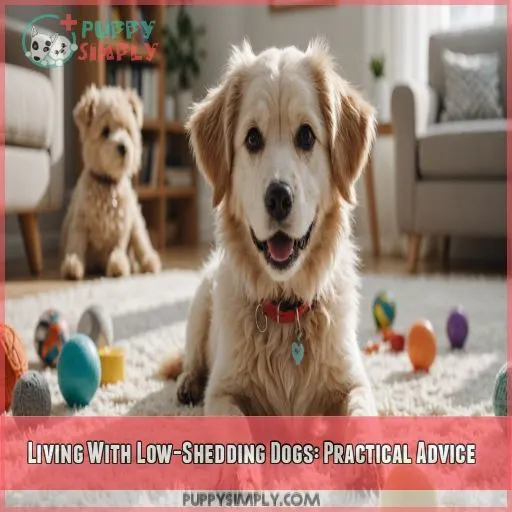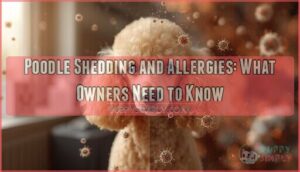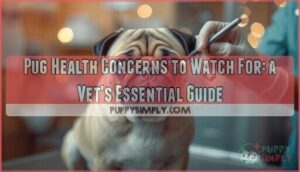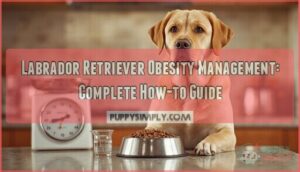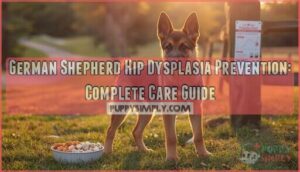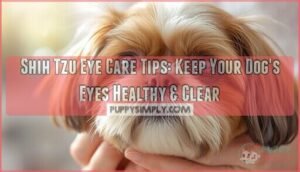This site is supported by our readers. We may earn a commission, at no cost to you, if you purchase through links.
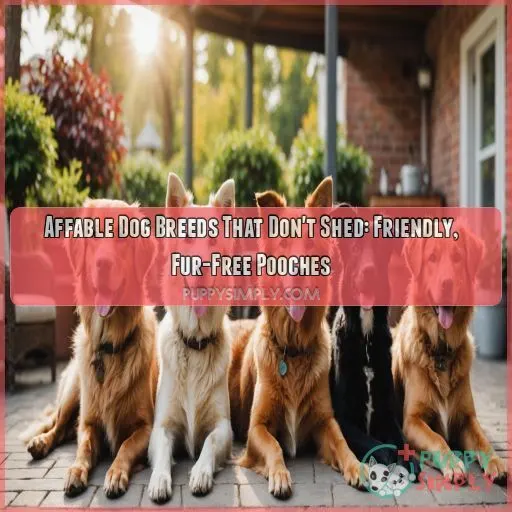
Terrier breeds like the Yorkshire, Scottish, and West Highland White are great options. They’re low-maintenance, friendly, and hypoallergenic. The Soft Coated Wheaten Terrier is another gentle and non-shedding breed that’s perfect for families.
If you’re after something a bit more unique, the Xoloitzcuintli or Peruvian Inca Orchid might be up your alley.
Whatever breed you choose, with the right care and attention, you’ll have a loving companion that won’t make you sneeze.
Table Of Contents
- Key Takeaways
- Terrier Breeds Known for Minimal Shedding
- Hypoallergenic Toy Breeds for Apartment Living
- Medium-Sized Non-Shedding Dogs for Active Families
- Rare Non-Shedding Breeds for Unique Pet Owners
- Grooming Tips for Low-Shedding Dog Breeds
- Health Considerations for Hypoallergenic Dog Breeds
- Training Low-Shedding Breeds: Challenges and Tips
- Adopting Vs Buying Non-Shedding Dog Breeds
- Living With Low-Shedding Dogs: Practical Advice
- Frequently Asked Questions (FAQs)
- Conclusion
Key Takeaways
- Finding a furry friend that doesn’t shed is like hitting the jackpot – and Terrier breeds, like the Yorkshire, Scottish, and West Highland White, are great places to start your search!
- Don’t let allergies get in the way of snuggling – hypoallergenic breeds, like Poodles, Bichon Frises, and Schnauzers, are perfect for families with allergy concerns, requiring less grooming and producing fewer allergens.
- When it comes to low-shedding dogs, grooming is key – regular brushing, nail trimming, and ear cleaning can help prevent matting, tangling, and skin issues, so get ready to get up close and personal with your new best friend!
- Whether you’re a busy bee or a laid-back lounger, there’s a low-shedding breed out there for you – from high-energy water dogs to laid-back lap dogs, do your research and find a furry friend that fits your lifestyle like a glove!
Terrier Breeds Known for Minimal Shedding
You’re looking for a furry friend that won’t leave a trail of fluff behind, and terrier breeds are a great place to start. From the spunky Yorkshire Terrier to the charming Soft Coated Wheaten Terrier, these breeds are known for their minimal shedding, making them perfect companions for those with allergies or a preference for low-maintenance grooming.
Yorkshire Terrier: Compact and Low-maintenance
You’re considering a Yorkshire Terrier as your new furry friend? These compact cuties are perfect for apartment living! With their silky, fine coats, they’re a great choice for those with allergies. Here are a few things to keep in mind:
- Yorkies are spunky and affectionate, but can be wary of strangers.
- Regular grooming is a must to prevent matting and tangling.
- They’re generally healthy, but can be prone to dental issues and hypoglycemia.
Scottish Terrier: Independent and Wire-coated
Meet the Scottish Terrier – a feisty, independent companion with a wire-coated charm. As a hypoallergenic breed, they shed minimally, but require regular grooming to prevent matting. Their temperament is affectionate, yet strong-willed. Daily exercise and mental stimulation will keep them happy and healthy. Perfect for allergy sufferers, this breed will bring joy and companionship to your life.
West Highland White Terrier: Friendly and Hypoallergenic
Meet the West Highland White Terrier, a friendly and feisty companion that’s perfect for families with allergies. Westies are known for their low-shedding coat, which requires regular grooming to prevent matting. With their big personality and small size, it’s no wonder why Westies are a popular choice for those seeking a hypoallergenic breed.
Soft Coated Wheaten Terrier: Gentle and Non-shedding
Meet the Soft Coated Wheaten Terrier, a gentle and non-shedding companion perfect for those with allergies.
With a friendly temperament and outgoing personality, they thrive on human interaction.
As a Wheaten Terrier owner, you’ll need to commit to regular grooming to prevent matting.
Be prepared for potential health concerns like hip dysplasia and protein-losing nephropathy, but with proper care, they’ll reward you with endless affection.
American Hairless Terrier: Completely Fur-free Option
You’re in luck if you’re searching for a completely fur-free companion! The American Hairless Terrier is a breed that comes in both hairless and coated varieties. Despite their lack of fur, they require regular skin care to prevent oil buildup. Friendly, outgoing, and curious, they’re perfect for families. Just remember, training is key to harnessing their energetic and playful temperament.
Hypoallergenic Toy Breeds for Apartment Living
You’re looking for a furry friend to share your apartment with, but allergies are a concern. Don’t worry, we’ve some great options for you with these hypoallergenic toy breeds that are perfect for apartment living, requiring minimal grooming and producing less dander to trigger allergies.
Shih Tzu: Long-haired but Low-shedding
If you’re thinking of bringing a Shih Tzu into your life, get ready for a loyal companion with a beautiful, low-shedding coat (Source). Their outgoing, friendly temperament makes them perfect for apartment living (Source). With regular grooming, they’ll stay clean and hypoallergenic .
- Brush their coat daily to prevent matting
- Provide regular exercise to prevent obesity
- Train them with positive reinforcement for a strong bond
Havanese: Silky Coat With Minimal Dander
The Havanese is another hypoallergenic toy breed perfect for apartment living.
Their silky coat requires regular grooming.
This playful pup is ideal for those with allergies.
Their friendly and outgoing temperament makes them a great companion, but be aware they can be mischievous if not properly trained.
Their minimal shedding coat reduces allergens, but regular brushing is a must.
Brussels Griffon: Affectionate and Low-allergen
Considering a Brussels Griffon as your new hypoallergenic companion? You’ll love their affectionate and playful nature! With a short, smooth coat that requires minimal grooming, they’re perfect for apartment living. However, they do need regular nail trimming and ear cleaning. Their adaptable temperament makes them great for families with children or for singles looking for a low-shedding lap dog.
Lhasa Apso: Long-lived and Low-shedding
Considering a Lhasa Apso as a hypoallergenic companion? You’re in luck! This adorable breed boasts a long lifespan (12-15 years) and low-shedding coat, perfect for apartment living. Here are some things to keep in mind:
- Lhasa Apso grooming: requires regular brushing to prevent matting
- Lhasa Apso temperament: playful, loving, and adaptable
- Lhasa Apso health: generally robust, but may be prone to eye and skin issues
Chinese Crested: Hairless and Powder Puff Varieties
Considering a Chinese Crested as a hypoallergenic companion? You’ve got two options: Hairless and Powder Puff! While both are low-shedding, they’ve distinct grooming needs.
| Characteristics | Hairless | Powder Puff |
|---|---|---|
| Grooming | Regular skin care, nail trimming | Frequent brushing, occasional bathing |
| Temperament | Playful, affectionate, alert | Gentle, playful, adaptable |
| Health Concerns | Skin issues, dental problems | Eye problems, patella luxation |
Both varieties make great apartment dogs, but you really need to research and understand their unique needs .
Medium-Sized Non-Shedding Dogs for Active Families
You’re looking for a furry friend that’s perfect for your active family, but you also want to minimize the amount of hair that’s left behind. Medium-sized non-shedding dogs are an excellent choice, offering the perfect balance of energy, affection, and low-maintenance grooming that’ll keep everyone happy and healthy.
Airedale Terrier: Energetic and Low-shedding
You’re an active family looking for a low-shedding companion that can keep up with your energetic lifestyle! The Airedale Terrier is an excellent choice. This medium-sized dog breed is hypoallergenic and full of life and love. Here are a few things to keep in mind:
- Grooming: Regular brushing is a must to prevent matting.
- Training: Positive reinforcement and consistency are key to developing good behavior.
- Temperament: Airedale Terriers are friendly, outgoing, and make great family pets.
Irish Water Spaniel: Playful and Hypoallergenic
You’ll adore the Irish Water Spaniel, a playful and hypoallergenic water dog! With proper training, they’ll be your best buddy. Regular grooming keeps their curly coat looking fabulous. Health-wise, keep an eye on their eyes and hips. Perfect for active families, this breed loves to splash and dash. Get ready for snuggles, slobbery kisses, and endless fun!
Bouvier Des Flandres: Loyal and Minimal Shedding
Looking for a loyal companion that keeps the shedding to a minimum?
Meet the Bouvier des Flandres!
This breed is intelligent, friendly, and adaptable.
With a history as a farm dog, they are known for their independent streak.
Regular grooming sessions are a must.
Early training will help manage their independent nature.
Consider adopting from a reputable breeder or rescue organization to bring this lovable giant home.
Standard Poodle: Intelligent and Non-shedding
Considering a Standard Poodle as your new family member? You’re in for a treat! Intelligent and non-shedding, this breed is perfect for active families with allergy concerns. With proper training and socialization, Standard Poodles become loving companions. Don’t forget regular grooming sessions to prevent matting. Their lifespan is around 12-15 years, making them a long-term best friend.
Soft Coated Wheaten Terrier: Friendly and Low-allergen
Considering a Soft Coated Wheaten Terrier? You’re in for a treat! This friendly and low-allergen breed is perfect for active families. Their silky coat requires regular brushing and grooming to prevent matting. With proper training, they’ll become a loving companion. Wheaten Terriers are generally healthy, but watch out for protein-losing nephropathy and Addison’s disease.
Rare Non-Shedding Breeds for Unique Pet Owners
If you’re looking for a truly one-of-a-kind companion, consider one of these rare non-shedding breeds that will make you stand out from the pack. From the ancient Xoloitzcuintli to the elegant Peruvian Inca Orchid, these unique dogs will bring a touch of individuality to your life, all while keeping your allergies in check.
Xoloitzcuintli: Ancient Mexican Hairless Breed
Are you ready for an ancient, affectionate companion? The Xoloitzcuintli (Mexican Hairless Dog) is a rare, hypoallergenic breed that doesn’t shed! With over 3,000 years of history, this breed comes in three sizes and boasts a unique, wedge-shaped head.
Here are three things to love about the Xolo:
- Alert and outgoing: Xolos are naturally vigilant, making great watchdogs.
- Athletic and agile: They require regular exercise to stay happy and healthy.
- Loyal and loving: Xolos bond strongly with their families, providing lifelong companionship.
Peruvian Inca Orchid: Elegant and Low-maintenance
Considering a Peruvian Inca Orchid? This elegant, low-maintenance breed is a great choice for those seeking a unique, affectionate companion. With a short, smooth coat that requires minimal grooming, they’re perfect for busy owners. Just be aware of potential skin issues and find a reputable breeder to make sure your new friend is healthy and happy.
Lagotto Romagnolo: Italian Truffle Hunter
You’re looking for a rare, low-shedding breed that’s as affectionate as it’s skilled? Enter the Lagotto Romagnolo, an Italian truffle hunter with a heart of gold! With its curly coat and energetic personality, this breed requires regular exercise and mental stimulation. Tip: They thrive on structure, so invest in dog training and clear boundaries.
Coton De Tulear: Rare Madagascar Breed
Meet the Coton de Tulear, a rare breed from Madagascar that’s as charming as it’s low-shedding. With a temperament that’s equal parts playful and affectionate, this small dog is perfect for families who want a hypoallergenic companion. Regular grooming is a must to prevent matting, but the Coton de Tulear’s soft, cottony coat is worth the extra effort.
Barbet: French Water Dog With Minimal Shedding
Meet the Barbet, a charming French Water Dog with minimal shedding! With a friendly, outgoing temperament, this rare breed is perfect for unique pet owners. Barbet grooming needs regular brushing to prevent matting, while early socialization and training help create a well-behaved companion. Rich in history, the Barbet has been a hypoallergenic favorite since the 16th century.
Grooming Tips for Low-Shedding Dog Breeds
As you welcome a low-shedding dog into your life, you’ll want to get familiar with the best grooming techniques to keep their coat looking its best – and your allergies at bay. In this section, we’ll break down the essential grooming tips for low-shedding dog breeds, covering everything from regular brushing techniques to bathing frequencies and professional grooming schedules.
Regular Brushing Techniques for Different Coat Types
You’ve found the perfect low-shedding companion! To keep their coat looking fabulous, regular brushing is a must. Here are some tips:
- Use a slicker brush for short coats (Labradoodle, Aussiedoodle) and a pin brush for longer coats (Bichon Frise, Portuguese Water Dog).
- Brush in the direction of hair growth to prevent matting.
- For curly coats (Goldendoodle), use a gentle, curly-hair brush.
- Brush your dog 2-3 times a week, depending on shedding frequency.
Bathing Frequency and Appropriate Shampoos
Bathing your low-shedding dog requires finesse. You want to keep them clean without stripping their coat of its natural oils. The ideal bathing frequency depends on their coat type and lifestyle. For example, a Maltese might need weekly baths, while a Toy Poodle can go up to 4 weeks between baths.
| Coat Type | Bathing Schedule | Shampoo Ingredients |
|---|---|---|
| Fine, silky (Maltese) | Weekly | Gentle, sulfate-free |
| Curly, non-shedding (Toy Poodle) | Every 2-4 weeks | Moisturizing, pH-balanced |
| Thick, double (Bolognese) | Every 4-6 weeks | Nourishing, protein-rich |
Remember to adjust the schedule according to seasonal changes and your dog’s individual needs. And, if you’re feeling adventurous, you can even try making your own DIY shampoo!
Professional Grooming Schedules and Styles
When talking about grooming schedules and styles for your dog, you’ll need to think about their coat type and breed-specific needs. For example, Schnauzers need regular beard trimming, while Bedlington Terriers need their signature "linty" coat texture maintained. Here are three grooming trends to keep in mind:
- Seasonal grooming: Adjust your dog’s grooming schedule according to the weather.
- Coat-type considerations: Different coat types require specific grooming styles and tools.
- Breed-specific styles: Research your dog’s breed to determine the best grooming style and schedule.
At-home Coat Maintenance Between Grooming Sessions
Between grooming sessions, keep your low-shedding dog’s coat looking fabulous with regular brushing techniques.
Brush, brush, brush – it’s key to shedding prevention!
For curly-haired breeds like the Lagotto Romagnolo, use a gentle sulfate-free shampoo and blot dry to prevent frizz.
For straight-coated breeds like the Chinese Crested, use a pin brush and conditioning spray to keep their locks silky smooth.
Health Considerations for Hypoallergenic Dog Breeds
When you’re thinking about getting a hypoallergenic dog, it’s important to be aware of the special health things to keep in mind with these breeds. Understanding the health issues that might pop up can help you give your new furry friend the best care and make sure you both have a happy and healthy life together.
Common Skin Conditions in Low-shedding Dogs
As a low-shedding dog parent, you’re not off the hook when it comes to skin issues. Keep an eye out for skin allergies, hot spots, dry skin, mange, and seborrhea. Hypoallergenic breeds can still get these conditions, especially in small spaces or city living. Regular grooming and check-ups can help prevent and treat these issues.
Nutritional Needs for Healthy Coat Maintenance
Now that we’ve covered common skin conditions, let’s talk nutrition! For a healthy coat, your hypoallergenic furry friend needs a balanced diet rich in omega-3s, protein, and hydration. Consider supplements if necessary. A well-nourished coat means less shedding and a happier pup. Focus on whole foods, and avoid fillers and by-products to keep your affable companion thriving.
Exercise Requirements for Different Breed Sizes
When it comes to exercise, hypoallergenic dogs are just like any other breed – they need physical activity to stay happy and healthy. The key is to match the exercise routine to the breed size and energy level. Here are some examples:
- Dandie Dinmont Terriers: short, daily walks
- Border Terriers: 30 minutes of playtime
- Cairn Terriers: active play sessions
- Small breeds: indoor games and short walks
- Large breeds: running, hiking, or playtime in the yard
Genetic Health Issues in Popular Non-shedding Breeds
When choosing an affable dog breed that doesn’t shed, you need to think about genetic health issues. Some popular non-shedding breeds are prone to specific health risks. Here are a few examples:
| Breed | Common Genetic Disorders | DNA Testing Benefits |
|---|---|---|
| Poodle | Hip dysplasia, eye problems | Early detection, informed breeding |
| Bichon Frise | Liver disease, patellar luxation | Identify carriers, reduce risk |
| Schnauzer | Eye problems, autoimmune disorders | Responsible breeding, healthier pups |
Regular Veterinary Care for Hypoallergenic Dogs
Caring for your hypoallergenic pup requires a bit of extra attention. Stay on top of their veterinary needs with these tips:
- Schedule regular check-ups to catch any skin issues early.
- Keep up with dental cleanings to prevent tartar buildup.
- Watch for ear infections, which can be common in some breeds.
- Follow your vet’s vaccination and parasite prevention schedule religiously.
Training Low-Shedding Breeds: Challenges and Tips
As you welcome a low-shedding breed into your life, you’ll want to get started on the right paw with training – and that means being aware of the unique challenges these dogs can bring. With patience, persistence, and positive reinforcement, you can help your new furry friend become a well-behaved and loving companion that brings joy to your life.
Intelligence Levels of Popular Non-shedding Breeds
When you’re teaching your non-shedding pup, you need to think about how smart they are.
Some breeds, like Poodles and Schnauzers, are really bright and love to use their brains.
Others, like Bichon Frises and Shih Tzus, can be a bit tougher to train because they’re independent.
Check out how intelligent your breed is so you can train them in a way that works best.
Positive Reinforcement Techniques for Stubborn Terriers
Training a stubborn terrier? Don’t worry, you’re not alone! Consistency is key when teaching these feisty friends. Establish a reward system that works for your terrier, and remember to be patient. With positive reinforcement methods, you’ll be well on your way to raising a well-behaved companion.
- Use treats and praise to encourage good behavior
- Be clear and consistent with commands
- Make training sessions short and fun
- Reward calm behavior in stressful situations
Socialization Importance for Small Hypoallergenic Dogs
As you welcome a small hypoallergenic dog into your life, remember that socialization is key. Enroll in puppy classes, visit dog parks, and arrange playdates to help your furry friend build confidence. This is especially important for breeds that thrive in urban, independent, or travel-rich lifestyles. Early socialization will help your dog navigate new experiences with ease.
Exercise-based Training for High-energy Water Dogs
You’ve socialized your small hypoallergenic dog, now it’s time to exercise-train your high-energy water dog! Engage your furry friend in:
- Agility courses: weave, jump, and tunnel their way to fun.
- Fetch games: retrieve, return, and revel in the thrill of the chase.
- Swimming routines: dock diving, anyone? Perfect for breeds like the Portuguese Water Dog.
Addressing Separation Anxiety in Affectionate Breeds
You’ve fallen head over heels for that adorable Afghan Hound or playful Malshi, but now you’re dealing with separation anxiety. Don’t worry, it’s common in affectionate breeds! Try calming techniques like crate training, enrichment toys, and hiring dog walkers. For severe cases, consider breeds like the Spanish Water Dog, perfect for therapy or service roles.
Adopting Vs Buying Non-Shedding Dog Breeds
As you consider bringing a new furry friend into your life, you’re likely wondering whether to adopt or buy a non-shedding dog breed. Let’s weigh the pros and cons of each option, so you can make an informed decision that suits your lifestyle and preferences.
Rescue Organizations Specializing in Hypoallergenic Dogs
When adopting a hypoallergenic dog, consider reaching out to a rescue network specializing in these breeds. Getting in touch with a network can increase your chances of an adoption success. Many rescues offer a range of breeds, promoting breed diversity, but also face shelter challenges. Some even provide financial aid to support your new furry friend’s needs.
Reputable Breeders for Rare Non-shedding Breeds
If you’re looking for a rare, non-shedding breed, reputable breeders are another option to consider.
When researching breeders, make sure to prioritize ethical breeding practices.
Look for breeders who specialize in dog breeds that are suited for large spaces or outdoor living, like Lagotto Romagnolos or Standard Poodles.
Be prepared for waiting lists and make sure you’re a good match for a breeder.
Research breed standards and ask about health testing.
Cost Comparisons Between Purebred and Mixed Breeds
If you’re looking at the price tag, purebred low-shedding dog breeds can be pricey, with adoption fees ranging from $500 to $2,000 (Source). Mixed breeds, on the other hand, can be adopted for a lower fee, between $50 to $200. However, remember to factor in ongoing costs like vet bills, food, grooming, and training, which can add up quickly.
Health Certifications to Look for When Adopting
When adopting a non-shedding dog, prioritize health certifications to avoid costly surprises.
Look for breeders who provide clearance for hip dysplasia, eye health, and genetic testing.
A temperament evaluation can also help make sure your new furry friend is a great match.
Research the breeder’s reputation and ask about their approach to health testing – your future companion will thank you!
Integrating a New Non-shedding Dog Into Your Home
When bringing a new non-shedding dog home, get your space ready to make things easier. Here’s a checklist to get you started:
- Dog-proof your home: Secure toxic substances, electrical cords, and fragile items.
- Stock up on pet supplies: Food, toys, and a comfy bed.
- Set up a training area: For housebreaking and obedience training.
- Allergy control: Invest in an air purifier and vacuum frequently.
Living With Low-Shedding Dogs: Practical Advice
As you welcome a low-shedding dog into your life, you’ll want to create a haven that’s both dog-friendly and low-allergen to make sure a happy and healthy coexistence. With a few simple tweaks, you can turn your home into a haven for both you and your new furry friend, where snuggles and playtime are always on the menu.
Creating a Dog-friendly, Low-allergen Home Environment
Now that you’ve adopted your hypoallergenic dog, let’s get your home dog-friendly and low-allergen ready! Swap your furniture for allergen-free alternatives and get dog-safe plants like spider plants or snake plants. Use pet-friendly decor that’s easy to clean. Don’t forget to dog-proof your home by securing loose wires and toxic substances. Your pup will thank you!
Managing Dog Allergies With Air Purifiers and Cleaners
Now that you’ve created a dog-friendly home, let’s tackle those pesky allergies. Invest in an air purifier with a HEPA filter, which can trap 99.97% of particles as small as 0.3 microns. Run it 24/7, especially in areas where your dog spends most of its time. Regular cleaning routines can also help reduce allergy triggers.
Traveling With Hypoallergenic Dogs: Tips and Considerations
Traveling with a hypoallergenic dog requires careful planning to ensure a smooth and enjoyable trip.
When flying, check airline policies and book pet-friendly hotels in advance.
For road trips, invest in a comfortable dog carrier and schedule regular breaks for exercise.
Don’t forget essential travel gear like food, water, and medication.
Consider potential health concerns like motion sickness and plan accordingly.
With proper preparation, you and your furry friend can embark on a stress-free adventure.
Introducing Non-shedding Dogs to Other Pets
Introducing your non-shedding dog to other pets? Start with a slow meet-and-greet, watching body language for signs of stress. Consider their play styles and energy levels to prevent territorial issues. Reward calm behavior with treats and praise. Train your dogs to basic commands to maintain harmony. With patience and practice, they’ll be BFFs in no time!
Long-term Care and Companionship of Low-shedding Breeds
Now that you’ve successfully introduced your low-shedding dog to other pets, it’s time to think about long-term care and companionship. Establish a regular grooming routine to prevent matting and tangling. Provide mental stimulation through training and play to prevent boredom. Keep in mind your dog’s breed-specific needs, health concerns, and ethical considerations to make sure they’ve a happy, healthy life.
Frequently Asked Questions (FAQs)
Can low-shedding dogs be left alone?
You’re wondering if low-shedding dogs can be left alone? Generally, it’s not a good idea to leave any dog alone for extended periods. They need attention, exercise, and interaction to stay happy and healthy.
What are hypoallergenic dogs for seniors?
If you’re a senior looking for a hypoallergenic dog, consider breeds like the gentle Maltese, playful Havanese, or affectionate Shih Tzu. These low-shedding companions are perfect for a quiet, low-maintenance lifestyle.
Are there hypoallergenic dogs for busy owners?
When life gets ruff, a low-maintenance pup can be a lifesaver! As a busy owner, consider hypoallergenic breeds like Poodles, Schnauzers, or Maltese that require less grooming and exercise, making them perfect for your hectic schedule.
What are low-shedding dogs for small spaces?
For small spaces, consider low-shedding dogs like Yorkshire Terriers, Havanese, or Poodles, which are perfect for apartment living due to their minimal shedding and adaptable nature.
Can hypoallergenic dogs go to daycare?
Sending your hypoallergenic dog to daycare can be like dropping off a child at school – you want to make sure they’re in good hands. Research dog daycare centers with experience handling hypoallergenic breeds and ask about their allergy-friendly policies.
Conclusion
Now that you’ve got the lowdown on affable dog breeds that don’t shed, it’s time to pick your perfect match!
With Terriers, Toy breeds, and rare breeds to choose from, you’ll find a furry friend that fits your lifestyle.
Happy tail-wagging with your new affable dog breed that doesn’t shed!

